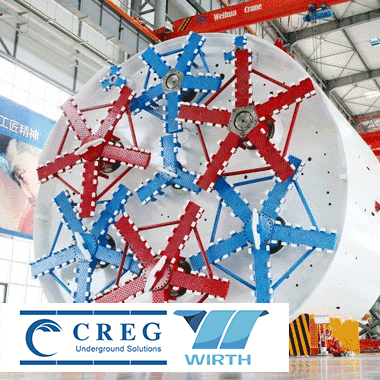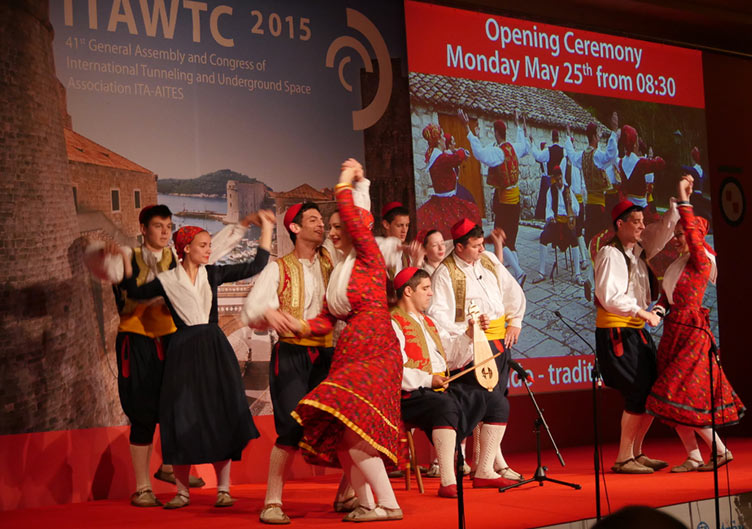Quantity above quality at WTC2015 Croatia 27 May 2015
The beautiful Croatian coastline and sunny weather were the perfect backdrop for the forging of new business opportunities and the making of fruitful connections between the 1,515 delegates attending WTC2015 in Dubrovnik this week. The lecture sessions, however, were a totally different story with quantity appearing to have been given far greater priority than quality.
Even the published Conference Proceedings were far too heavy to carry around. Food was in plentiful supply during the lunch buffets, but not even so much as a glass of water was provided by way of a beverage, except during the short coffee breaks. Delegates who did not stay at the conference hotel were confused about how to pay for their lunchtime drinks.
Monday afternoon saw the opening of the Exhibition Area, this year featuring 140 booths, and the start of the much-anticipated technical sessions. During the week the hefty total of 390 lectures were due to be delivered, across six simultaneously running sessions. But poor organisation and an evident lack of advance quality checks led to a situation whereby it appeared that anyone had been allowed to present anything.
Most sessions ran over time, making it difficult for individual delegates to plan their personal schedule. Signage and session advertising were scarce, with many delegates seen to be walking around aimlessly trying to find the right rooms. The quality of many lectures was very poor, with far too many presenters conveying no real message or, conversely, going into so much detail that even experts in their respective fields were seen drifting off. On Tuesday afternoon and Wednesday morning, some sessions were cancelled without prior notice, as presenters or panel chairmen failed to show up.
Competition on everybody's time was fierce. This became painfully obvious during the truly interesting ITA opening session on hydropower plants – an important topic for the South Eastern European region. Held on Tuesday morning, the session was competing for delegates with five other simultaneously running presentations. This led, disappointingly, to engineers, power plant owners and other highly regarded speakers from all over the world who had been specially invited to share their expert knowledge suffering the indignity of delivering their critical insights to a very poorly attended session.
The ITA, too, was not immune from making scheduling foul-ups of its own, with ITA-COSUF, ITA-TECH and ITACUS workshops all placed in the same time slots, in different rooms, and even in different hotels.
Extrusion control
This year's Muir Wood Lecture had little to do with the WTC, and its presenter – Professor Pietro Lunardi – was permitted to deliver it in Italian. For this single lecture, headphones and translators were brought in, but the technology and the translating left much to be desired. Most of the detail of what proved to be an unusually technical Muir Wood Lecture were, somewhat understandably, lost in translation.
Lunardi, Professor at the Universities of Pavlova, Florence and Parma, spoke to his audience about his work on the Fréjus tunnel on the border between France and Italy. He explained his extrusion control method of the ground core at the tunnel excavation face, which is used to stabilise cavities. “At the Fréjus tunnel, 25 years ago, extrusion control measures were taken for the first time. Since then, my method has proved reliable in over 100km of tunnelling,” said Lunardi. “We finalised the results into a design and construction approach which we called the analysis of deformation of rocks and soils.”
Awards
Still, there are of course good things to report and plenty to celebrate. On Monday morning the ITACET Foundation Award was granted posthumously to Dr Koichi Ono, who passed away only recently. His wife Mazako was invited to accept the award on his behalf. “Dr Koichi Ono was an exceptional engineer, teacher and mentor for a generation of engineers,” said ITA President Søren Eskesen. Mazako said the next generation of engineers was always close to Dr Koichi’s heart. “It was really important to him to encourage young engineers,” she told delegates.
WTC Past President, Professor In-Mo Lee (2010-2013), received the Honorary President Award from ITA Croatia 2015. In the lecture that followed his award, Prof Lee shared his future vision for even more metro lines, better techniques to cope with ground water, and the continuing drive by the underground construction industry to make cities more resilient, sustainable and better connected. “In Korea we also have a dream to connect the Korean peninsula with the mainland of China and Japan,” he said.
Ancient Greece
A surprising and inspiring lecture was delivered by Professor Theodosis Tassios, who presented his research on underground construction in ancient Greece, a refreshing take on tunnelling from a total different point of view. “In ancient Greece there were very high penalties for contractors and suppliers who did not deliver,” he said. “Also, there was no difference between an architect and a civil engineer.” Even at this early date contracts were already very detailed and, quite literally, etched in stone. By 600 BC, or shortly thereafter, every Greek city had its own long distance underground aqueducts.

ITA Croatia President Davorin Kolić (right), passes the ITA banner to Bill Egerton (centre) and Michael Smithson (left), representing the USA, ahead of WTC2016 in San Francisco
Prof Tassios ended his ITA Heritage Lecture with a self-directed animated film which was very well received by attendees. It showed the planning and construction of the Eupalinos tunnel in Samos. This 1km-long aqueduct was built around 550 BC and is known as the second tunnel in history to be excavated from both ends, and the first one such to feature a geometry-based approach.
WTC 2018
At the General Assembly 54 countries cast their votes for the country that will host WTC2018. With 29 votes, Dubai came out as the winner, and so the WTC will pass to the growth region of the Middle East where new metros are currently in construction in Riyadh, Saudi Arabia, and Doha in Qatar, and likely to be under construction soon in Mecca and Jeddah. A number of large drainage tunnels are also being excavated in the region. India received 22 votes, with three countries abstaining from voting.
Next year the WTC gathering moves to San Francisco, USA, earlier than usual – in the week April 22-28. In 2017 the event moves back to Europe – to Bergen in Norway.
In the coming weeks TunnelTalk will try to provide a full coverage of the conference, sharing most of the highlights and an ITA progress report.
Feedback from WTC delegates and exhibitors:
I read the article, and I have to say I completely agree with your report! While the show was in a gorgeous setting and the organizers couldn’t have been nicer, there were some serious organizational errors. From our perspective, we worked very hard to research and write papers, make the presentations, and send our authors to the conference. The session rooms were so hard to find and far apart, and there were never more than maybe 30 to 40 people in each session. This was also due to multiple simultaneous tracks. I also found the quality of some papers to be lacking and the sessions very hard to time as the papers were shuffled around. There were some wonderful papers in the program but but getting to them was the hard part!
I am in full agreement with your conference analysis! And where did the €95 for the dinner banquet go? Certainly not into food and drinks! It needs to be said, however, that transport for the airport transfers were organized perfectly! I was a WTC2015 delegate, presenter, and session chairman but I was lost logistically most of the time, and informed of being a session chairman by email only on the Friday before the conference started! If sessions were missing their chairperson, this is not a surprise.
References
- Croatia plans for an underground future – TunnelTalk, May 2015
- Technical focus on inspection and safety – TunnelTalk, May 2015
|
|
|
|
|
Add your comment
- Thank you for taking the time to share your thoughts and comments. You share in the wider tunnelling community, so please keep your comments smart and civil. Don't attack other readers personally, and keep your language professional.






